Harpers Ferry Brewing Company/Harpers Ferry Bottling Company
Introduction
Text-to-speech Audio
James McGraw opened his beer bottling business in 1885 and built a bottling plant behind his business on Block B, along Market Street. His son, James C. McGraw, expanded the business by constructing a new brewery and ice plant behind Block C by 1897, naming it the Harpers Ferry Brewing Company. The brewery was operated under several owners in the twentieth century and a fire in 1909 destroyed the main brewery. Between 1916 and 1942, the bottling plant continued operations as the Harpers Ferry Bottling Company.
Images
Close-up of the brewery and bottling buildings in the 1896 view of Harpers Ferry
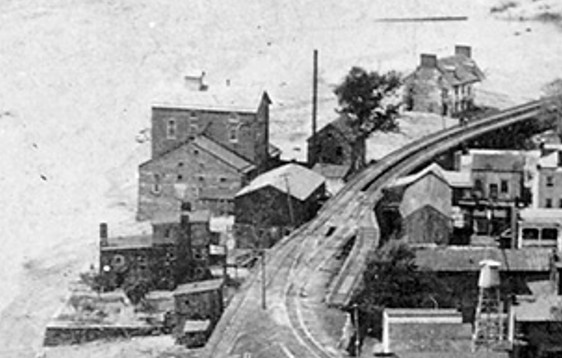
Harpers Ferry in 1896, the brewery is the large building at the left of the image
.jpg)
Sanborn Fire Insurance Map, Nov. 1894: the bottling plant is labeled on Market Street and the new brewery building appears to be started on the other side of the railroad tracks.
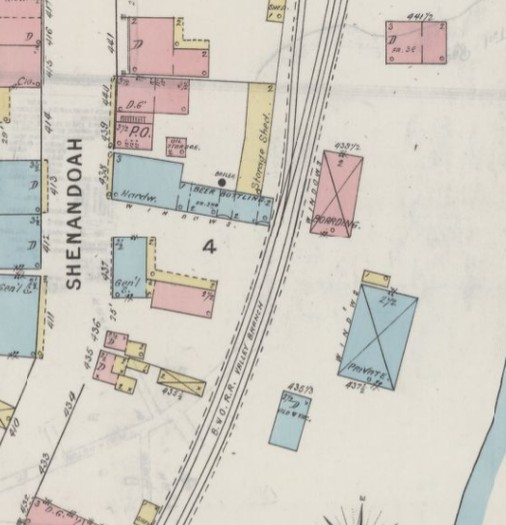
Sanborn Fire Insurance Map, Aug. 1902: The brewery is now under the Belvidere Brewing Company. The beer botting plant is labeled on Market Street and the full brew house/ice house is visible.
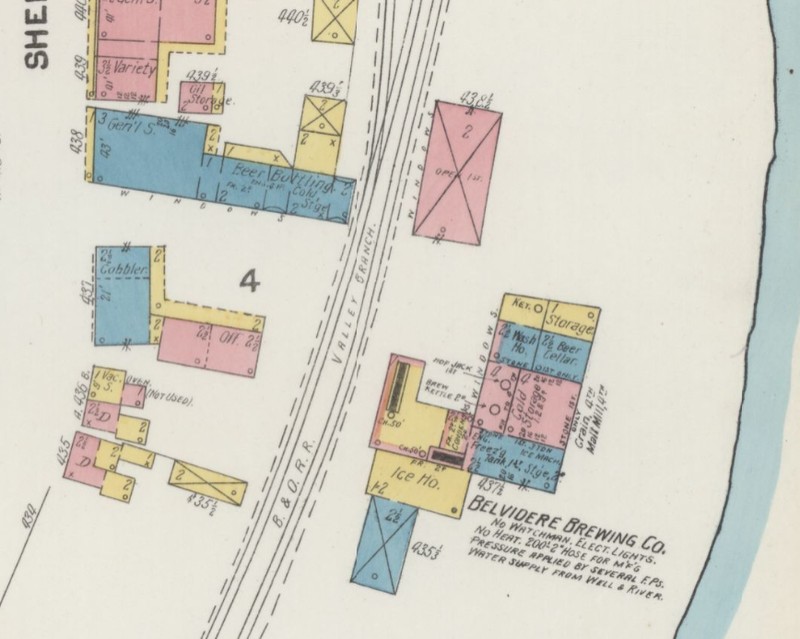
Sanborn Fire Insurance Map, Sept. 1907: Now under the name Jefferson Brewing Company, it appears that the bottling operation has transferred from the original building into the main brewery plant.
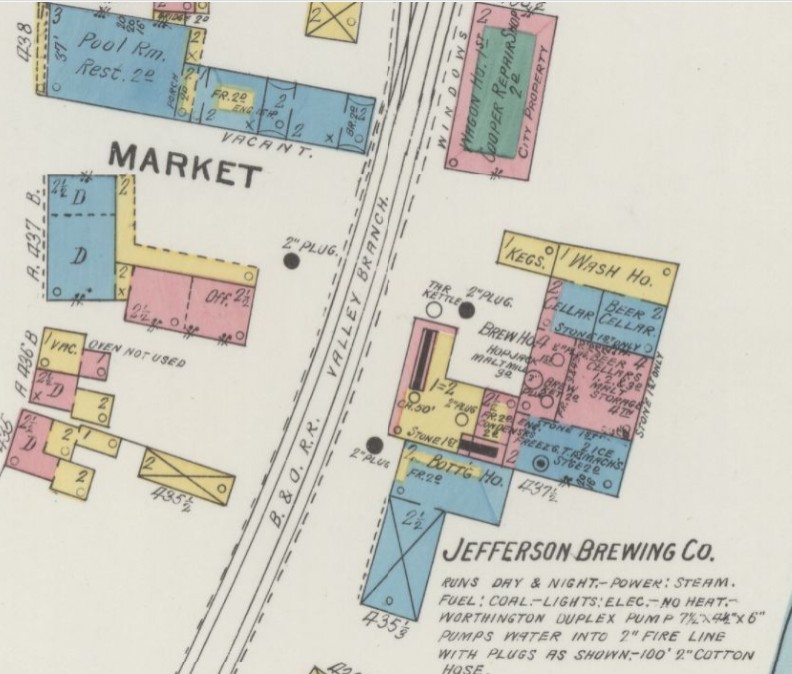
Sanborn Fire Insurance Map, Nov 1922: Under its final ownership as the Harpers Ferry Bottling Works, parts of the building is labeled as "ruins" after the 1909 fire.
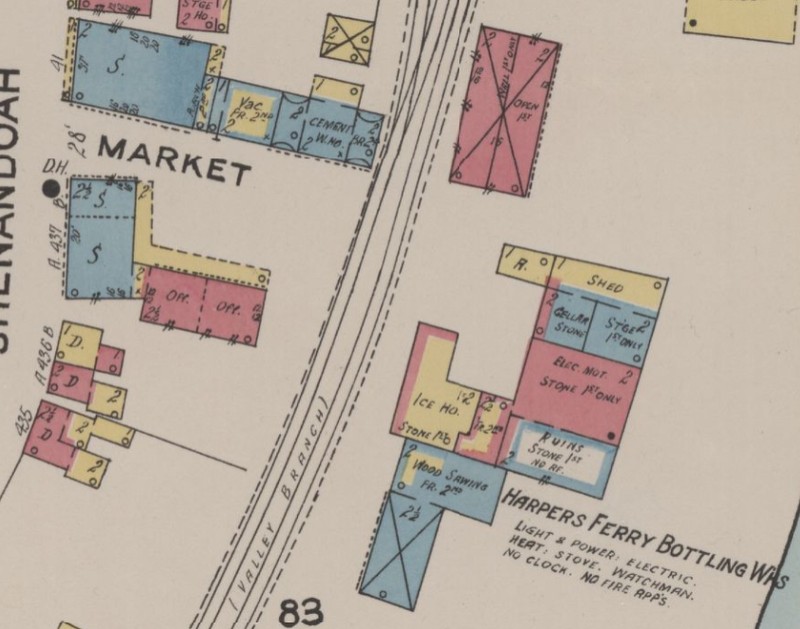
Sanborn Fire Insurance Map, May 1933: Parts of the building still listed as vacant or in ruins while other are labeled as the Bottling Works.
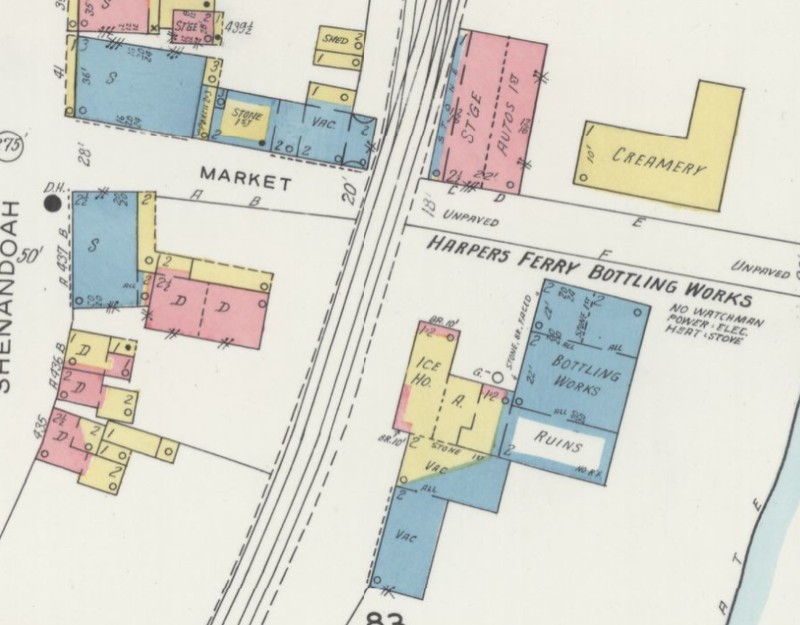
"Old bottling works after flood," 1942
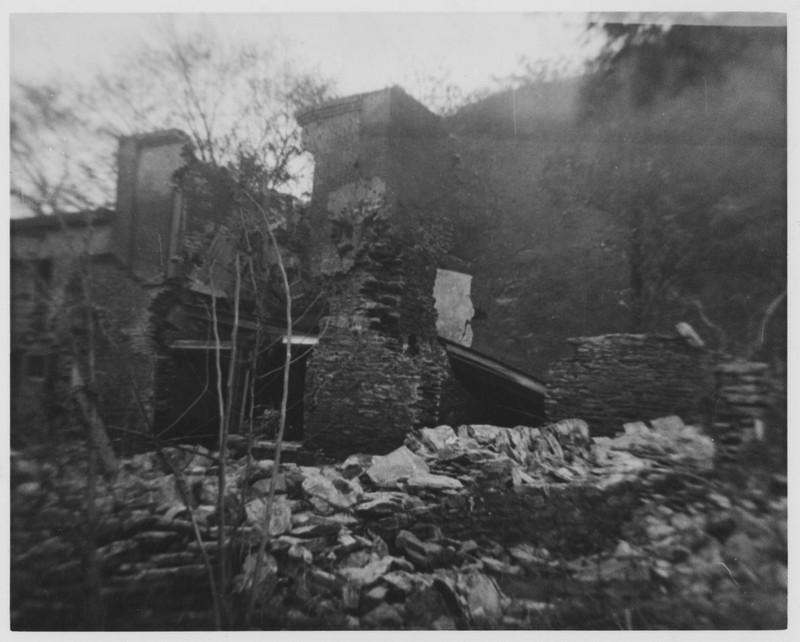
"Old bottling works after flood," 1942
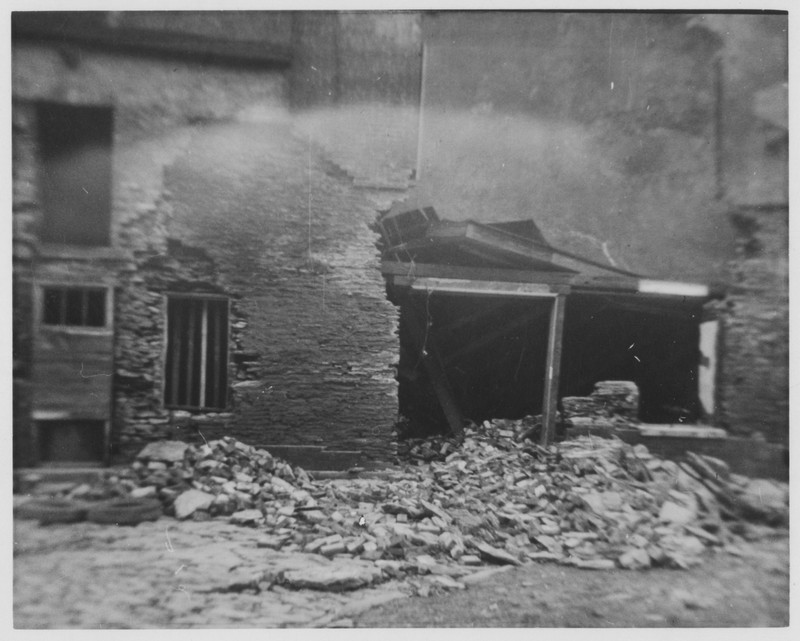
Wayside Marker at Harpers Ferry National Historical Park
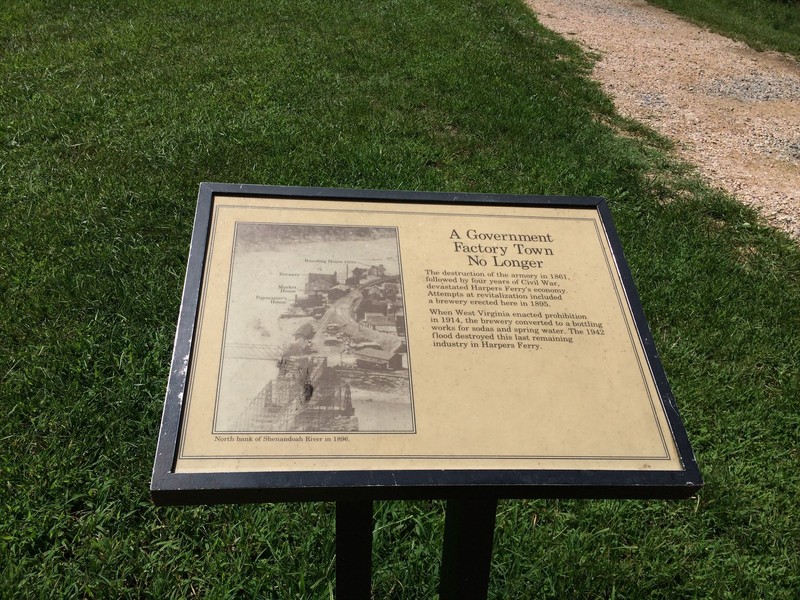
Backstory and Context
Text-to-speech Audio
James McGraw first opened a beer bottling business in 1885 and advertised Milwaukee Lager Beer. In 1888, he built a bottling plant directly behind his main business on Block B of Shenandoah Street. Two years later, McGraw transferred part of the business over to his son, James C. McGraw, and advertisements indicate that the business had expanded to selling Sachs Puden ginger ale, Pilsner beer, and Pabst Milwaukee beer.
James McGraw died in 1893, and his son, James C. McGraw, inherited the entire business. The younger McGraw was ambitious and quickly expanded the business, constructing a new brewery behind Block C. The brewery building was located separate from the bottling plant, between the Shenandoah River and B&O railroad tracks. McGraw spent $30,000 to expand his operations into the newly named Harpers Ferry Brewing Company and by 1897 he was brewing beer and bottling it in the steam-powered bottling plant, as well as manufacturing and bottling soft drinks and manufacturing ice. The entire industry was worth $50,000, but McGraw had taken on loans to expand and in the summer of 1897 a fire at the brewery caused $6,000 of damages. Three months after the fire, McGraw declared bankruptcy and the brewery was put up for sale.
McGraw’s bankruptcy lawyer, James M. Mason, continued to operate the brewery between October and January while he searched for a buyer, but he struggled to find someone to purchase the brewery property. In February 1898, Mason sold the brewery to August Krueger of Cincinnati, OH; however, Krueger turned out to be a less than credible buyer and the brewery failed by that June. After changing ownership a few times, the brewery operation was purchased by the Leder-Weideman Brewing Company in 1903. The Jefferson Brewing Company purchased the brewery in 1905 but suffered a devastating fire in January 1909 that destroyed the main brew house and ice plant (the bottling plant survived). Unable to rebuild, the owners sold the property to the German Brewing Company in 1909 who used it as part of their distribution operations.
Charles T. Smith purchased the brewery in 1916 and established the Harpers Ferry Bottling Works. Prohibition was in effect in West Virginia starting in 1914, so between 1914 and 1933 (during state and then national prohibition) there was no beer production at the plant, but the Bottling Works continued to produce soft drinks. The Harpers Ferry Bottling Works operated until 1942 when it was destroyed in a flood.
Sources
Hull-Walski, Deborah A., and Frank L. Walski. “There’s Trouble a-Brewin’: The Brewing and Bottling Industries at Harpers Ferry, West Virginia.” Historical Archaeology 28, 4 [An Archaeology of Harpers Ferry’s Commercial and Residential District] (1994): 106-121.
"Lower Town." Harpers Ferry Explorer. Dave Gilbert Graphic Design. Accessed September 27, 2021. http://www.dgilbert53.net/?page_id=448#gallery/449/48.
"Lower Town." Harpers Ferry Explorer. Dave Gilbert Graphic Design. Accessed September 27, 2021. http://www.dgilbert53.net/?page_id=448#gallery/449/48.
Sanborn Fire Insurance Map from Harpers Ferry, Jefferson County, West Virginia. Sanborn Map Company, Nov, 1894. Map. https://www.loc.gov/item/sanborn09407_001/. Accessed September 27, 2021. https://www.loc.gov/resource/g3894hm.g3894hm_g094071894/?sp=2&r=0.212,0.478,1.121,0.544,0.
Sanborn Fire Insurance Map from Harpers Ferry, Jefferson County, West Virginia. Sanborn Map Company, Aug, 1902. Map. Retrieved from the Library of Congress, <www.loc.gov/item/sanborn09407_002/>. Accessed September 27, 2021. https://www.loc.gov/resource/g3894hm.g3894hm_g094071902/?sp=2&r=0.573,0.484,0.542,0.263,0.
Sanborn Fire Insurance Map from Harpers Ferry, Jefferson County, West Virginia. Sanborn Map Company, Sep, 1907. Map. https://www.loc.gov/item/sanborn09407_003/. Accessed September 27, 2021. https://www.loc.gov/resource/g3894hm.g3894hm_g094071907/?sp=2&r=0.641,0.589,0.377,0.183,0.
Sanborn Fire Insurance Map from Harpers Ferry, Jefferson County, West Virginia. Sanborn Map Company, Nov, 1922. Map. https://www.loc.gov/item/sanborn09407_005/. Accessed September 27, 2021. https://www.loc.gov/resource/g3894hm.g3894hm_g094071922/?sp=2&r=0.642,0.631,0.377,0.183,0.
Sanborn Fire Insurance Map from Harpers Ferry, Jefferson County, West Virginia. Sanborn Map Company, May, 1933. Map. https://www.loc.gov/item/sanborn09407_007/. Accessed September 27, 2021. https://www.loc.gov/resource/g3894hm.g3894hm_g094071933/?sp=2&r=0.547,0.568,0.542,0.263,0.
"Old bottling works after the flood." Harpers Ferry National Historical Park. Open Parks Network. Accessed September 27, 2021. https://openparksnetwork.org/single-item-view/?oid=OPN_NS:0ADD14C894318213E325DBE4BDDAEFA5&b=https%3A%2F%2Fopenparksnetwork.org%2Fsearch-results%2F%3Fk%3Dbottling%26opn_refine_control%3Djump%26xi%3D1%26xm%3D20%26sf%3D%26facet-contributinginstitution%5B%5D%3DHarpers%2520Ferry%2520National%2520Historical%2520Park.
"Old bottling works after the flood." Harpers Ferry National Historical Park. Open Parks Network. Accessed September 27, 2021. https://openparksnetwork.org/single-item-view/?oid=OPN_NS:F91B006EE89A9B4B011913D9C4611942&b=https%3A%2F%2Fopenparksnetwork.org%2Fsearch-results%2F%3Fk%3Dbottling%26opn_refine_control%3Djump%26xi%3D1%26xm%3D20%26sf%3D%26facet-contributinginstitution%5B%5D%3DHarpers%2520Ferry%2520National%2520Historical%2520Park.
"Remaining Industry in Harpers Ferry." Waymarking.com. Accessed September 27, 2021. https://www.waymarking.com/waymarks/WM13X5E_LAST_Remaining_Industry_in_Harpers_Ferry_Harpers_Ferry_WV.
